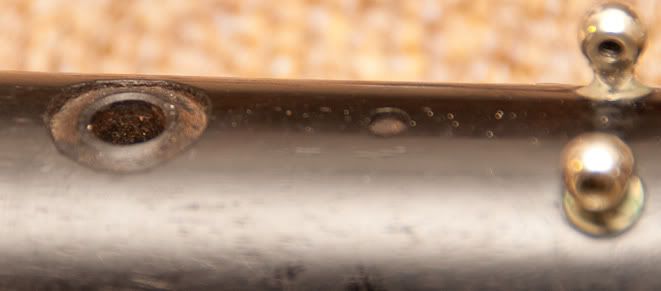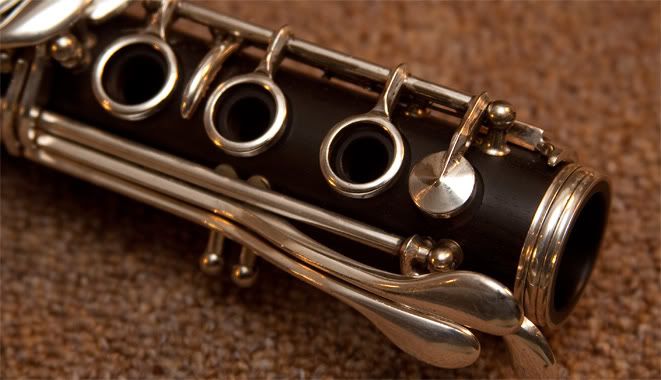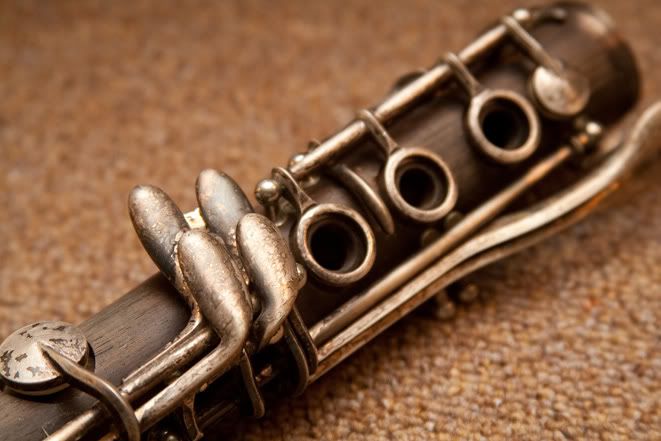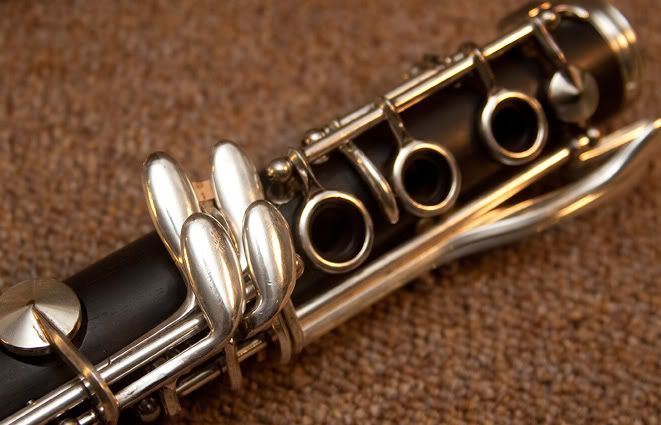 The Clarinet BBoard The Clarinet BBoard
|
Author: Chris J
Date: 2011-05-03 07:43
I am overhauling an old Couesnon Eb soprano. It probably dates from the early 1930s.
This is the first Eb I have had (it was a whim and ripe for repairing).
There is no register tube, and what was there looked very tone hole like, so I carried on regardless.
The instrument didn't play before I overhauled it, and now it seem clear that it does indeed need a register pip as the pinch Bb plays nearly a C!
So I am looking for some dimensions to experiment around. The diameter of the hole is 4.6mm so giving external diameter of the tube. What would be a good starting point for internal diameter and protrusion into the bore?

Chris
|
|
Reply To Message
|
|
Author: clarnibass
Date: 2011-05-03 07:58
My Eb (not a Couesnon) has a 2.3mm diameter tube. Though I don't know if it's the same diameter for its entire length (didn't remove it). I think I would start with about 2.0mm or maybe a little less, then start enlarging it and check. I'd probably start with a plastic tube that would slide easily but seal, then enlarge it to check. For me that's just easier for experimenting than a metal tube. Maybe slightly taper each end of the hole, at least to remove a rough edge. Possibly try several lengths. Remember to check both clarion and throat Bb since the relationship between length and diameter (also shape, can be tapered or even hourglass) can give the best compromise between the two purposes.
|
|
Reply To Message
|
|
Author: clarnibass
Date: 2011-05-04 07:09
So what diameter was the B&H reg tube?
P.S. Although the cleaning looks good and I would wash it too probably, I actually prefer the before dull look of the keys
Post Edited (2011-05-04 07:12)
|
|
Reply To Message
|
|
Author: Chris J
Date: 2011-05-04 07:49
I did not actually measure the intenal diameter of the tube exactly, but to remove it I heated the shank of a 3mm drill to place inside it to release the shellac which was a snug fit
So theoretically probably too large a bore than there should be, but as the instrument seemed to be in tune with itself I will leave it at that.
This is the first time I have played an Eb sop, so as I get used to it and then if it seems that some fine tuning is needed, at least it is a great starting point within which I can experiment with inserts or wax to reduce the bore.
Chris
|
|
Reply To Message
|
|
Author: Chris J
Date: 2011-05-04 08:23
And I know what you mean about the dull keys. If they all looked like the touch pieces of the right little finger then it would have been tempting to leave them, but some of the pad cups, posts and other bits of metal were quite green. The rings on the barrel and bell were pretty grotty.
So it was all or nothing!
Chris
|
|
Reply To Message
|
|
Author: Chris P
Date: 2011-05-04 10:38
If the speaker tube diameter is too large, it can always be filled in with wax and then resized.
At least now the keys and all other nickel silver parts have been polished, they'll all dull down at a similar rate but won't have the orange and green build-up on them. I went a bit overboard when I rebuilt my Buffet Eb as I added an adjusting screw to the throat G# key and had all the keys and other non-ferrous parts silver plated (apart from the bell ring). The keys had the dreaded 'red rot' so took some tidying up.
It's amazing how oiling can bring the wood back to life. I rebuilt an early '50s wooden Regent (this one had keywork like a 926 and not in mazak) and the transformation from looking washed out to having a deep sheen was incredible.
I would invest in a new or better case for it (and there are loads to choose from) as those spring clips aren't exactly the friendliest of things!
Former oboe finisher
Howarth of London
1998 - 2010
Independent Woodwind Repairer
Single and Double Reed Specialist
Oboes, Clarinets and Saxes
NOT A MEMBER OF N.A.M.I.R.
The opinions I express are my own.
|
|
Reply To Message
|
|
Author: Chris P
Date: 2011-05-04 12:26
Pitted nickel plating is probably the worst kind to tidy up due to how hard it is (against how soft the base metal is). Then again, pitted chrome plating (eg. Buffet bassoons) is probably ten time worse to have to do any kind of work on.
Former oboe finisher
Howarth of London
1998 - 2010
Independent Woodwind Repairer
Single and Double Reed Specialist
Oboes, Clarinets and Saxes
NOT A MEMBER OF N.A.M.I.R.
The opinions I express are my own.
|
|
Reply To Message
|
|
Author: lhoffman
Date: 2011-05-05 19:28
Chris P, that horn looks fantastic. I've overhauled a few clarinets, just as a hobby, but I don't have any means of buffing keys. What equipment do you use? You've inspired me.
|
|
Reply To Message
|
|
Author: Chris P
Date: 2011-05-05 19:51
You mean Chris J there!
Former oboe finisher
Howarth of London
1998 - 2010
Independent Woodwind Repairer
Single and Double Reed Specialist
Oboes, Clarinets and Saxes
NOT A MEMBER OF N.A.M.I.R.
The opinions I express are my own.
|
|
Reply To Message
|
|
Author: Chris J
Date: 2011-05-05 21:15
Chris J here...
Of course the proper way is with a large buffing wheel.
But as a hobby repairer, with time on my hands so doing it for relaxation, not profit, I use a small dremel hand tool with a wool mop in the chuck, regularly putting a buffing compound on the spinning mop.
The buffing compound I use is Hyfin .
It is all close hand work, but once you have got the hang of not letting the mop spin the key out of your fingers (or letting the key spin the mop into your fingers) then it is surprisingly quick. It takes me an afternoon to do a set of clarinet keys.
A proper buffing wheel probably takes 15 to 30 minutes?....
Once finished, I degrease the key with Naphtha lighter fuel (incl hinge and rod)
I like to pad with white leather bassoon pads

Chris
Post Edited (2011-05-05 21:16)
|
|
Reply To Message
|
|
Author: Chris P
Date: 2011-05-06 06:43
I think Hyfin is probably too harsh for nickel silver or silver plating when using a large buffing machine - you're best with tripoli for nickel silver and jewellers' rouge for silver plate with large mops. I only use Hyfin on steel to get a mirror finish on it.
Former oboe finisher
Howarth of London
1998 - 2010
Independent Woodwind Repairer
Single and Double Reed Specialist
Oboes, Clarinets and Saxes
NOT A MEMBER OF N.A.M.I.R.
The opinions I express are my own.
|
|
Reply To Message
|
|
The Clarinet Pages
|
 |











![[whoa]](http://test.woodwind.org/clarinet/BBoard/smileys/smilie10.gif)

